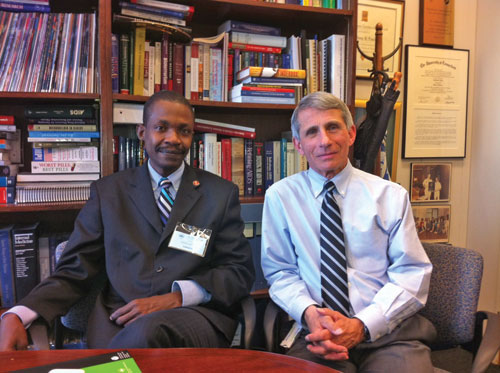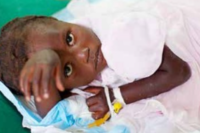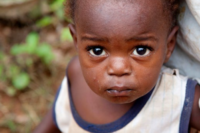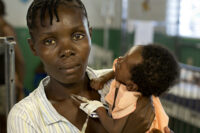On March 8th and 9th, Dr. Harold Prévil, Hôpital Sacré Coeur’s new CEO, visited the Bethesda, Maryland campus of the National Institute of Health. The visit came at a fortuitous time; days before the quarterly board meeting of the CRUDEM Foundation, a few weeks after Dr. Prévil stepped into his new executive role, and immediately after he completed his Masters Degree in Hospital Administration and Health Care from the University of Montreal College of Medicine and Pharmacy.
Dr. Prévil visited two of the 19 NIH institutes: the National Institute of Allergy and Infectious Disease (NIAID) and the Eunice Kennedy Schriver National Institute for Child Health and Human Development (NICHD.)
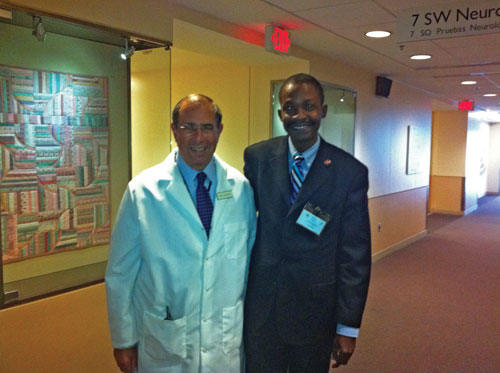 At NIAID, Dr. Prévil discussed the hospital’s PEPFAR clinic for AIDS treatment and received briefings from Dr. Anthony Fauci, Dr. Cliff Lane and Dr. John Gallin. Since the 1980 outbreak of the AIDS virus, these three scientists have been closely identified with the NIH research and have made major contributions in identifying the latent stages and current treatment regimens.
At NIAID, Dr. Prévil discussed the hospital’s PEPFAR clinic for AIDS treatment and received briefings from Dr. Anthony Fauci, Dr. Cliff Lane and Dr. John Gallin. Since the 1980 outbreak of the AIDS virus, these three scientists have been closely identified with the NIH research and have made major contributions in identifying the latent stages and current treatment regimens.
In addition to conducting his research in inherited immune disorders, Dr. John Gallin heads the Clinical Center, known in the medical world as “America’s Research Hospital.” Dr. Gallin conducted a briefing and tour of the 246 bed facility sustained by its $397.2 million budget. The center’s enviable research facilities include: a high tech metabolic chamber equipped to study body fat composition, an isolation ward with air locks and decontamination entry locks to safely study highly contagious diseases, separate mechanical/utility floors, tucked between each patient floor, to support research labs and patient room floors, where Phase I and II clinical studies are underway. At present, the center is studying 383 rare diseases. Dr. Gallin listed some of the past achievements such as cancer chemotherapy (childhood leukemia, choriocarcinoma among the early firsts,) the first artificial mitral valve replacement and even dental cavity protection research which lead to use of fluoride gel.
Dr. Anthony Fauci talked with Dr. Prévil about how early on during the NIH research; there emerged an unnamed and confusing complex of infectious disease symptoms associated with rarely seen manifestations. These phenomenons gradually awakened the consciousness of many of his young fellow researchers in the early 1980’s. Dr. Fauci recalled reading a journal report of an infection in late 1980, “we were aware that CMV was an important cause of infection in gay men. I thought there was some mutation of CMV that gave a very virulent course in these individuals and was suppressing their immune systems. But I put the idea to the back of my mind. Then when a second report came in later that summer, I started to get a little worried thinking there might be the emergence of a new disease. Very soon thereafter, still in 1982, towards the early fall; it became clear that IV (intravenous) drug users were getting AIDS. I can remember that I started to get goose pimples. I said, ‘My goodness. This could be an infection that is transmitted by blood and sex, and I do not have the foggiest idea what it is.’”
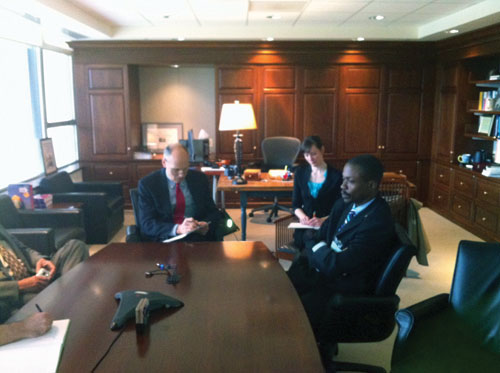 Dr. Fauci recalled receiving a call from a referring doctor in lower Virginia, right about this time, who asked permission to send the first AIDS patient to NIH. There was a major mid Atlantic snow storm occurring. Dr. Fauci told the physician, “If the patient can make it in, we will receive him.” The patient made it to the Institute and became the first AIDS patient admitted to NIH.
Dr. Fauci recalled receiving a call from a referring doctor in lower Virginia, right about this time, who asked permission to send the first AIDS patient to NIH. There was a major mid Atlantic snow storm occurring. Dr. Fauci told the physician, “If the patient can make it in, we will receive him.” The patient made it to the Institute and became the first AIDS patient admitted to NIH.
At that time, Dr. Cliff Lane was finishing in a post medical school training fellowship in infectious diseases and starting a NIH research project to investigate human immune responses to antigens (stimuli to produce antibodies.) He laughed as he recalled that not all his clinical work with AIDS patients was in a lab or hospital room. Many researchers in the 1970s thought that infectious diseases study was simply a matter of filling in the blanks based on the identification of infections microbes and medications. With sufficient resources, early researchers hypothesized major progress in diseases that might have once been considered challenging could occur. The surge that is now called AIDS proved this hope wrong.
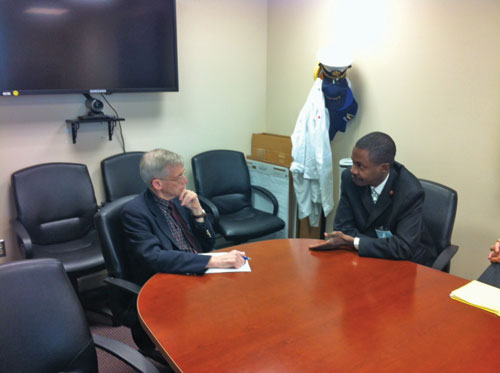 Dr. Ken Bridbord, another early AIDs research pioneer, is at the Fogarty International Center of NIH where he directs the worldwide training for researchers. Dr. Bridbord has been honored for his support of efforts to reduce disparities in global health. Make no mistake about it, he told Dr. Prévil, disparities still exist. Dr. Bridbord listed sobering statistics about infectious diseases, many commonly seen in Haiti. AIDS, for example has claimed an estimated 30 million people worldwide. In 2009, 9.4 million new cases of Tb were reported and 1.7 million died from the infection. Malaria affects 22.5 million of the world’s people and 780,000 deaths have occurred. Drs. Bridbord and Prévil concurred that neglected tropical diseases, such as filariasis and leishmaniasis, must be a key focus for NIH.
Dr. Ken Bridbord, another early AIDs research pioneer, is at the Fogarty International Center of NIH where he directs the worldwide training for researchers. Dr. Bridbord has been honored for his support of efforts to reduce disparities in global health. Make no mistake about it, he told Dr. Prévil, disparities still exist. Dr. Bridbord listed sobering statistics about infectious diseases, many commonly seen in Haiti. AIDS, for example has claimed an estimated 30 million people worldwide. In 2009, 9.4 million new cases of Tb were reported and 1.7 million died from the infection. Malaria affects 22.5 million of the world’s people and 780,000 deaths have occurred. Drs. Bridbord and Prévil concurred that neglected tropical diseases, such as filariasis and leishmaniasis, must be a key focus for NIH.
Everyone at the meeting agreed that Haiti’s easy access for US investigators portends fruitful partnerships in disease projects.
Dr. Alan Guttmacher is director of the second major institute Dr. Previl visited, the Eunice Kennedy Schriver National institute for Child Health and Human Development (NICHD.) This institute is charged with care for woman and children. Dr. Guttmacher gathered his staff together to discuss the UN Millennium Development Goals (MDG) # 4 reduce childhood mortality, measured by reducing newborn mortality rate, and #5 improve woman’s health by reducing mortality rate in childbirth by 75 percent.
As Dr. Guttmacher noted, progress for women’s care will also be determined by the increase in number of traditional birth attendants. (These are lay individuals without any formal training who have no recognition by any official body). Currently in Haiti, 630/100,000 women die from childbirth, the highest rate in the Western hemisphere. Statistics across the border for the neighboring Dominican Republic are a world apart with deaths of 150 women per 100,000. Haiti, where only 24-25% of births are attended by a qualified birth attendant, presents an opportunity for improvement. Neonatal mortality in Haiti is also tragically high.
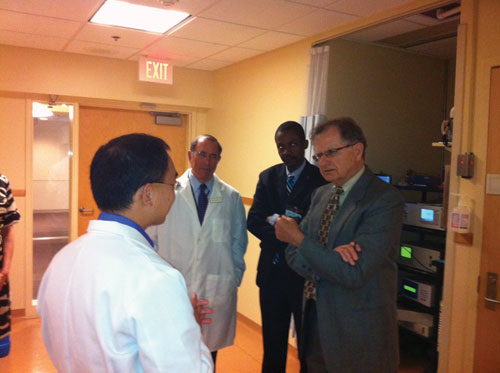 A major topic for the group of experts gathered around the conference table was the recent roll out by NIH of some simple unsophisticated tools for less developed areas. One tool discussed was the Helping Babies Breathe (HBB) initiative that focuses on The Golden Minute (time given for non-breathing infant to begin respiratory function.) Dr. Prévil pointed out that Hôpital Sacré Coeur has conducted HBB training sessions with Certified Master Trainers since the onset of the international program.
A major topic for the group of experts gathered around the conference table was the recent roll out by NIH of some simple unsophisticated tools for less developed areas. One tool discussed was the Helping Babies Breathe (HBB) initiative that focuses on The Golden Minute (time given for non-breathing infant to begin respiratory function.) Dr. Prévil pointed out that Hôpital Sacré Coeur has conducted HBB training sessions with Certified Master Trainers since the onset of the international program.
Less than 24 hours after returning from an overseas teaching trip, Dr. Anne Berger R.N.,MD, NIH Chief of Pain and Palliative Care Service, offered her advice to Dr. Prévil. Dr. Berger had worked as a Masters degree R.N. in oncology nursing for several years before earning an M.D. degree and fellowships at Yale in medical oncology, palliative care and pain management. She immediately agreed to the need for palliative care to be introduced to Haiti, after observing similar post earthquake type problems in other third world disasters. Dr. Prévil shared his experiences of how Haitian earthquake survivors supported each other by singing hymns and gathering in groups. Dr. Berger agreed with Dr. Prévil’s assessment that these comforting actions helped assuage some of the pain of the trauma. Both physicians further agreed that medically prescribed pain medication also needs to be provided to trauma patients. Dr. Berger quickly noted that the same problems of supply, control and safe, non-criminal dispensing of medications plague every less developed, impoverished area where she has consulted. As Dr. Prévil stated, these challenges beset Haiti on a daily basis. Dr. Berger promised to bring the experiences she learned in Ireland, Croatia and Palestine to help Hôpital Sacré Coeur as it establishes one of the first palliative care programs in Haiti.
 Before leaving the following morning for St. Louis, Dr Prévil met with Dr. Jon Andrus, Deputy Director of the Pan American Health Organization, and James Fitzgerald his Senior Advisor on Essential Drugs. Again the problem of distribution of needed medicines was a major part of the discussion.
Before leaving the following morning for St. Louis, Dr Prévil met with Dr. Jon Andrus, Deputy Director of the Pan American Health Organization, and James Fitzgerald his Senior Advisor on Essential Drugs. Again the problem of distribution of needed medicines was a major part of the discussion.
All in all, it was clear that during the time Dr. Prévil spent at NIH realistic goals and strategies to make HSC a working haven of healing and education for the people of northern Haiti were aided.


